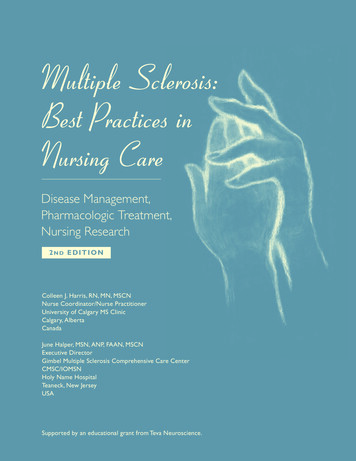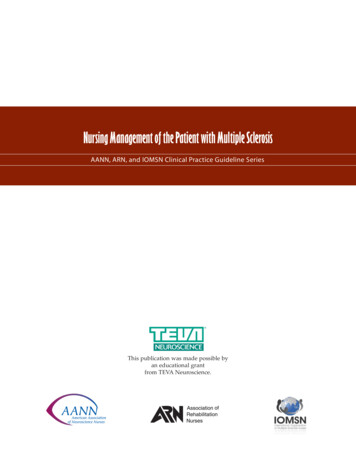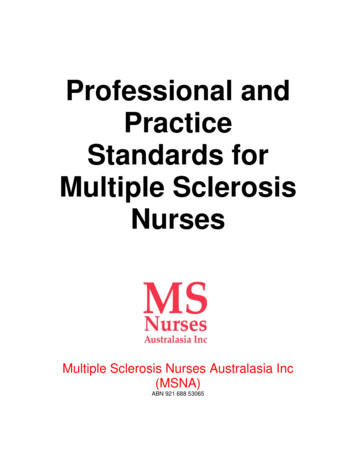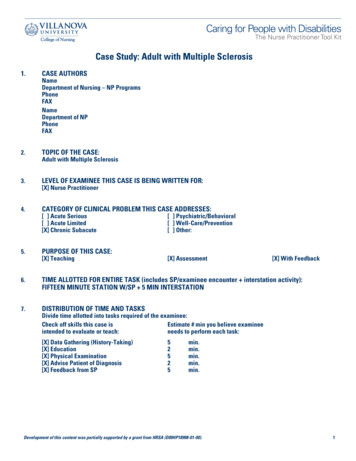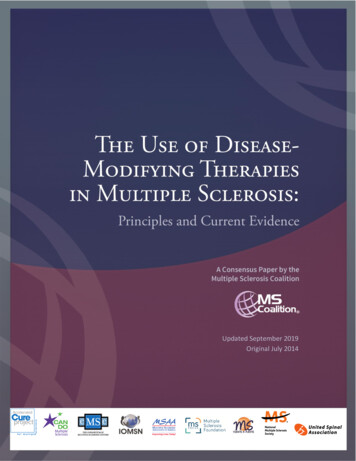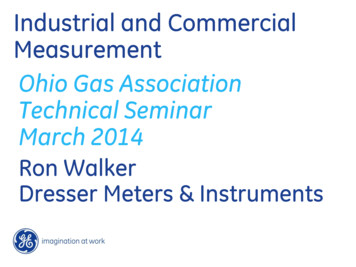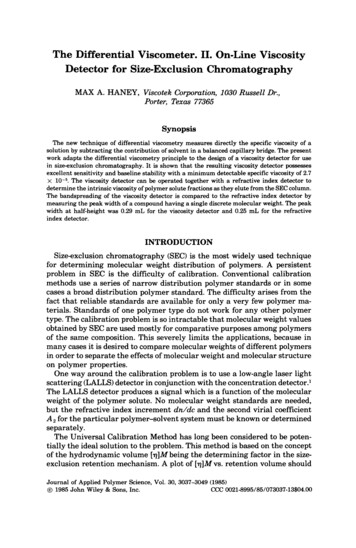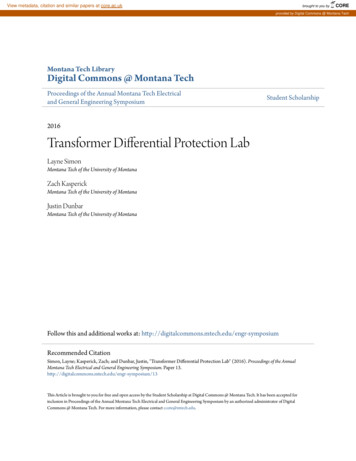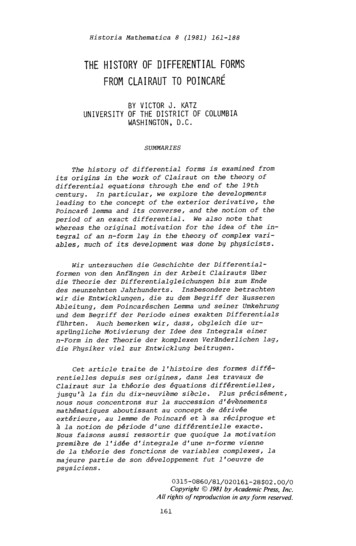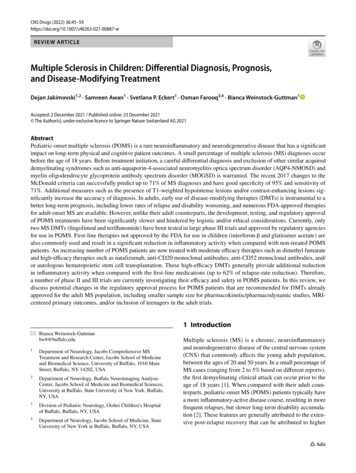
Transcription
CNS Drugs (2022) -wREVIEW ARTICLEMultiple Sclerosis in Children: Differential Diagnosis, Prognosis,and Disease‑Modifying TreatmentDejan Jakimovski1,2 · Samreen Awan1 · Svetlana P. Eckert1 · Osman Farooq3,4 · Bianca Weinstock‑Guttman1Accepted: 2 December 2021 / Published online: 23 December 2021 The Author(s), under exclusive licence to Springer Nature Switzerland AG 2021AbstractPediatric-onset multiple sclerosis (POMS) is a rare neuroinflammatory and neurodegenerative disease that has a significantimpact on long-term physical and cognitive patient outcomes. A small percentage of multiple sclerosis (MS) diagnoses occurbefore the age of 18 years. Before treatment initiation, a careful differential diagnosis and exclusion of other similar acquireddemyelinating syndromes such as anti-aquaporin-4-associated neuromyelitis optica spectrum disorder (AQP4-NMOSD) andmyelin oligodendrocyte glycoprotein antibody spectrum disorder (MOGSD) is warranted. The recent 2017 changes to theMcDonald criteria can successfully predict up to 71% of MS diagnoses and have good specificity of 95% and sensitivity of71%. Additional measures such as the presence of T1-weighted hypointense lesions and/or contrast-enhancing lesions significantly increase the accuracy of diagnosis. In adults, early use of disease-modifying therapies (DMTs) is instrumental to abetter long-term prognosis, including lower rates of relapse and disability worsening, and numerous FDA-approved therapiesfor adult-onset MS are available. However, unlike their adult counterparts, the development, testing, and regulatory approvalof POMS treatments have been significantly slower and hindered by logistic and/or ethical considerations. Currently, onlytwo MS DMTs (fingolimod and teriflunomide) have been tested in large phase III trials and approved by regulatory agenciesfor use in POMS. First-line therapies not approved by the FDA for use in children (interferon-β and glatiramer acetate) arealso commonly used and result in a significant reduction in inflammatory activity when compared with non-treated POMSpatients. An increasing number of POMS patients are now treated with moderate efficacy therapies such as dimethyl fumarateand high-efficacy therapies such as natalizumab, anti-CD20 monoclonal antibodies, anti-CD52 monoclonal antibodies, and/or autologous hematopoietic stem cell transplantation. These high-efficacy DMTs generally provide additional reductionin inflammatory activity when compared with the first-line medications (up to 62% of relapse-rate reduction). Therefore,a number of phase II and III trials are currently investigating their efficacy and safety in POMS patients. In this review, wediscuss potential changes in the regulatory approval process for POMS patients that are recommended for DMTs alreadyapproved for the adult MS population, including smaller sample size for pharmacokinetic/pharmacodynamic studies, MRIcentered primary outcomes, and/or inclusion of teenagers in the adult trials.1 Introduction* Bianca Weinstock‑Guttmanbw8@buffalo.edu1Department of Neurology, Jacobs Comprehensive MSTreatment and Research Center, Jacobs School of Medicineand Biomedical Science, University of Buffalo, 1010 MainStreet, Buffalo, NY 14202, USA2Department of Neurology, Buffalo Neuroimaging AnalysisCenter, Jacobs School of Medicine and Biomedical Sciences,University at Buffalo, State University of New York, Buffalo,NY, USA3Division of Pediatric Neurology, Oishei Children’s Hospitalof Buffalo, Buffalo, NY, USA4Department of Neurology, Jacobs School of Medicine, StateUniversity of New York at Buffalo, Buffalo, NY, USAMultiple sclerosis (MS) is a chronic, neuroinflammatoryand neurodegenerative disease of the central nervous system(CNS) that commonly affects the young adult population,between the ages of 20 and 50 years. In a small percentage ofMS cases (ranging from 2 to 5% based on different reports),the first demyelinating clinical attack can occur prior to theage of 18 years [1]. When compared with their adult counterparts, pediatric-onset MS (POMS) patients typically havea more inflammatory-active disease course, resulting in morefrequent relapses, but slower long-term disability accumulation [2]. These features are generally attributed to the extensive post-relapse recovery that can be attributed to higherVol.:(0123456789)
46Key PointsThere is a significant disparity in the availability ofdisease-modifying treatment (DMT) options betweenadult-onset multiple sclerosis (AOMS) and pediatriconset multiple sclerosis (POMS).Only two MS-based medications were recently investigated in a double-blind, randomized, phase III POMStrial and received regulatory approval.Multiple logistical and ethical concerns hinder the development and testing of DMTs for the POMS population.ability for myelin repair/synthesis and greater plasticity ofthe developing brain [3].Although POMS patients have relatively slower physicaldisability progression, the early and frequent neuroinflammatory attacks can result in impaired brain development andpoorer cognitive performance when compared with adultonset MS (AOMS) patients or non-MS peers [4, 5]. Theseimpairments can have long-term consequences, including alower likelihood of pursuing higher education, lower annualearning, frequent sick days during work life, and earlyenrollment into disability pension programs [6]. Therefore,efforts towards early diagnosis, discovery of early predictorsof long-term outcomes, and appropriate early drug intervention are highly warranted [7].This narrative review will focus on the current diagnosis and management of POMS, exploring the efficacy andsafety characteristics of the currently available drug armamentarium. A succinct description of POMS diagnosis, differential diagnosis, and factors identified to interfere withMS long-term clinical outcomes will be presented also. Datareported in the manuscript was collected through a search ofPubMed, EMBASE, and Scopus entries up to June 26, 2021using MeSH terms such ‘pediatric MS,’ ‘POMS,’ ‘multiplesclerosis’ AND ‘children’ and ‘DMT’ OR ‘disease-modifying treatment’ AND ‘Pediatric MS’. Additional literaturederived from the references of the retrieved manuscripts andpersonal databases were utilized.2 Incidence and Prevalenceof Pediatric‑Onset Multiple Sclerosis(POMS)Comparably to the adult MS distribution, a systematicreview performed in 2016 suggested significant geographical heterogeneity in the incidence and prevalence of POMSD. Jakimovski et al.[8]. Data ranged from the lowest incidence of 0.05 per100,000 children in Tunisia to 2.85 per 100,000 childrenin Sardinia, Italy [8]. In addition to the study from Sardiniashowing higher incidence and one more from Kuwait (2.1per 100,000), all remaining studies report incidence that was 1 case per 100,000 children [8]. A smaller number of studies also provided the overall prevalence of POMS, whichranges from 0.69 per 100,000 children in Japan to 26.92cases per 100,000 children in Sardinia, Italy [8]. The latestupdate of the MS Atlas estimates that currently there are atleast 30,000 children living with MS (data derived from 47reporting countries).A recent meta-analysis that included 13 epidemiological studies estimated the global annual incidence of pediatric onset MS at 0.87 per 100,000 individuals [9]. Regionalsubgroup analysis was only feasible for Europe (0.78 per100,000 individuals) and the Middle East (0.89 per 100,000individuals) [9]. Interestingly, the overall incidence differedbased on which diagnostic criteria were used, with 0.92 per100,000 individuals for the 2013 International PediatricMultiple Sclerosis Study Group (IPMSSG) criteria and 1.67per 100,000 individuals for the 2010 McDonald criteria [9].The global prevalence of POMS cases was estimated at 8.11cases per 100,000 people [9]. In comparison with the 2013IPMSSG criteria and/or 2010 McDonald criteria, anotherstudy that estimated the incidence and prevalence of POMSin Ontario, Canada utilized different diagnostic criteria thatare based on administrative data claims [10]. Based on theirfindings, this world region had the highest POMS burdenwith a recent increase in annual POMS incidence, goingfrom 0.61 per 100,000 in 2003 to 0.98 or 1.24 per 100,000in 2014 [10]. Based on their criteria, the study estimated thatthe Ontario region (with a population of over 14 million) hadbetween 114 and 191 children living with MS [10].In comparison, fewer studies have investigated theincidence and prevalence of pediatric aquaporin-4 antibody-associated neuromyelitis optica spectrum disorder(AQP4-NMOSD). Between 2008 and 2018, a Danish population-based study recorded four such patients and estimatedthe incidence at 0.031 per 100,000 [11]. Similar incidencedata was seen in Catalonia with pediatric NMOSD estimated at 0.037 per 100,000 [12]. The prevalence of pediatric NMOSD in Japan was estimated at 0.06 per 100,000children [13]. With the upcoming development of myelinoligodendrocyte glycoprotein antibody spectrum disorder(MOGSD) diagnostic criteria and greater availability of antiMOG antibody testing, future studies will be able to betterdetermine the incidence and prevalence of this neuroinflammatory entity and separate it from POMS.
47Pediatric MS: Diagnosis, Prognosis and Treatment3 Diagnosis of POMS and DifferentialDiagnosisAn event of acquired CNS demyelination in childrenyounger than 18 years old, also known as acquired demyelinating syndrome (ADS), could represent one of manyneuroinflammatory diseases including AQP4-NMOSD,MOGSD, acute disseminated encephalomyelitis (ADEM)with encephalopathy, or a monophasic disease [14]. In fact,only 20% of pediatric ADS cases are ultimately diagnosedwith POMS [15]. Table 1 demonstrates some of the keyclinical, laboratory, and neuroimaging characteristics thatcan aid the differential diagnosis between the ADS presentations. Similar and more comprehensive illustrations can befound elsewhere. Moreover, the typical magnetic resonanceimaging (MRI) findings seen in a 10-year-old MS patient, an8-year-old AQP-4-positive NMOSD patient, an 11-year-oldMOGSD patient, and an ADEM patient are shown in Fig. 1.The diagnosis of POMS is undertaken through the lensof the adult McDonald MS diagnostic criteria and its latest2017 revision. The diagnostic utility was recently analyzedin a nationwide study of 324 patients with ADS who werefollowed for 6 years after their first attack [15]. Over the follow-up period, a total of 71 (22%) children were diagnosedwith MS. The 2017 McDonald criteria successfully predicted 71% of the MS diagnoses with specificity and sensitivity of 95% and 71%, respectively [15]. When comparedwith the 2010 revision (53% correctly identified), the 2017McDonald criteria contributed an additional 18% increasein diagnostic sensitivity [15]. Apart from the McDonald criteria parameters, a random forest analysis isolated severaldifferentiating features between multiple sclerosis and otherADS-based disorders, including the presence of at least oneT1-weighted hypointense lesion (black hole), at least onegadolinium-enhancing lesion, at least one periventricularlesion, and presence of oligoclonal bands [15]. The use ofthese criteria had excellent sensitivity and specificity of84% and 93%, respectively [16]. The diagnosis of pediatricAQP4-positive or negative NMOSD should be performedthrough the recent adult diagnostic criteria, while formalMOGSD diagnostic criteria are currently in development[17]. Similar diagnostic algorithms that utilize a mixture ofclinical, imaging, and serological features have been previously proposed and generally categorize patients in fourmain distinct phenotypes of MS, NMOSD with AQP4-Ab,MOG-Ab-associated disease, and seronegative relapsingdemyelinating syndromes [18].Table 1 Demographic, clinical, laboratory and imaging characteristics of the different acquired demyelinating syndrome presentationsF:MTypical age of onsetMonophasic or recurrentClinical and imaging featuresOptic neuritisPapillitisTransverse myelitisInfratentorial pathologyADEM presentationCSF OSDMOGSD2:1 10 years oldRecurrent4:1 10 years oldRecurrent1:1 10 years old50% of MOGSD patients haverelapses and 50% have monophasic diseaseUnilateral short and focal ONlesionsRareBilateral ON lesions involving the More often having bilateral longchiasm and optic tractsON lesions when compared withMS (unilateral ON can occur inMOGSD)RareCommonCommon LETM extending inCommon LETMbrainstemLarge cerebellar lesions extending Large cerebellar lesions extendingthrough the cerebellar peduncles through the cerebellar pedunclescan occur more often than in MSand mid-brainOccasionalCommon initial presentationNever presentVery rareCommonFrequentAlways presentNever presentRareCommonRareShort segments commonly affecting C-spineSmall focal lesionsNever presentAlways presentRareCommonTable modified from Fadda et al. [14]ADEM acute disseminated encephalomyelitis, AQP4-NMOSD aquaporin-4 neuromyelitis optica spectrum disorder, CSF cerebrospinal fluid, F:Mfemale:male, LETM longitudinal extensive transverse myelitis, MOGSD myelin oligodendrocyte glycoprotein antibody spectrum disorder, MSmultiple sclerosis, OCB oligoclonal bands, ON optic neuritis, POMS pediatric-onset multiple sclerosis
48D. Jakimovski et al.Fig. 1 MRI-based differential diagnosis of pediatric patients with multiple sclerosis, neuromyelitis optica spectrum disorder, myelin oligodendrocyte spectrum disorder, and acute demyelinatingencephalomyelitis. A, B Axial FLAIR images demonstrating typicalMS-based hyperintensities within the periventricular region, juxtacortical region, and in the posterior fossa (cerebellum). C, D SagittalT2 image of the spinal cord and axial FLAIR image demonstratinglongitudinal extensive transverse myelitis that involves the brainstemregion and extend over the entire cervical portion of the spinal cord.E, F Axial post-contrast FLAIR image demonstrating bilateral opticneuritis with optic nerve edema associated with contrast enhancementof the optic nerve and perineural sheet. Coronal T2 image demonstrating cervical spinal cord lesion spanning over 2.5 vertebral levels.G, H Axial FLAIR images demonstrate multiple, diffuse, ‘fluffy,’poorly defined T2 hyperintense lesions involving both grey and whitematter and both supra- and infratentorial region. ADEM acute disseminated encephalomyelitis, FLAIR fluid-attenuated inversion recoveryMOGSD myelin oligodendrocyte glycoprotein antibody spectrum disorder, MS multiple sclerosis, NMOSD neuromyelitis optica spectrumdisordersA recent European Union (EU)-based pediatric MOGconsortium consensus was provided, with multiple separatestatements addressing the MOG-associated clinical features[19], neuroimaging features [20], the use of different available assays for MOG-antibody testing and other biomarkerssuch as neurofilament light chain [21], the clinical outcomesof pediatric MOGSD [22], and a final part that reviews thecurrent acute and maintenance treatment options [23].4 Disability Outcomes, Predictors,and Importance of Treatment in POMSThe earliest large data reporting on long-term outcome inPOMS came from the European Database for Multiple Sclerosis (EDMUS) network, which included 394 patients 16years old with the diagnosis of MS (7.6% of patients withdiagnosis were 10 years old). These data suggested thatthe transition into secondary progressive MS occurred aftera median of 28.1 years and at a median age of 41.4 years [2].Moreover, the POMS patients had disability progression toan Expanded Disability Status Scale (EDSS) score of 6.0(not able to walk for 100 m without the need of unilateral support) after a median disease duration of 28.9 years[2]. Although the time from disease onset to certain EDSSscores was significantly longer when compared with theirAOMS counterparts, POMS patients were still on average10 years younger [2]. Approximately 50% of these POMSpatients were at some point treated with disease-modifyingtherapy (DMT), but most data stemmed from early 1976to 2001 when none of the patients received treatment earlyin their disease course. To better account for the diseaseduration as part of the disease severity, a recent adaptationof the Multiple Sclerosis Severity Scale (MSSS) for POMSpatients has been proposed (Ped-MSSS) [24].Over the last several years, multiple large observationalstudies have reported on long-term outcomes in patientswith POMS [7, 25]. A recent Italian registry study includeda total of 3198 patients with POMS who were followedfor an average of 21.8 years [7]. The time to reach different disability levels was significantly decreased with each
49Pediatric MS: Diagnosis, Prognosis and Treatmentdiagnosis epoch (up to 50–70% when compared with thenatural history), which can be attributed mainly to the initiation of highly efficacious drugs during the pediatric ageand continued use of DMT for a longer period of time whencompared with prior epochs [7]. In a similar fashion, 549POMS patients from the Swedish MS registry also took significantly longer time to reach certain EDSS milestones, butstill were younger when compared with the AOMS cohort[25]. Faster progression in this POMS group was associatedwith a greater number of relapses during the first 5 years ofthe disease (5.35 times greater risk of reaching EDSS 4.0)and being classified with a primary progressive (PP) course(4.63 times greater risk), while complete recovery from thefirst relapse was associated with 59% lower risk of reachingan EDSS of 4.0 [25].Reports also suggest additional predictors of long-termoutcomes, including the occurrence of the first two demyelinating attacks within the same year of disease onset asbeing associated with a greater risk of new relapse and progression to EDSS disability score of 4.0 [26]. Moreover,POMS patients with the first demyelinating attack affecting the brainstem have a significantly greater risk for futuredisability progression (up to 5 times) when compared withpatients with lesions in other CNS locations [27]. In a recent9-year follow-up study, early treatment with high-efficacymedication resulted in a significantly longer time to a newrelapse [28]. The presence of cerebellar lesions at baselineand high-efficacy medications was also associated with alower long-term annualized relapse rate (ARR), whereaspresentation of transverse myelitis was associated with ahigher ARR over the follow-up [28]. In terms of long-termdisability outcome, the occurrence of two new T2 hyperintensities and an EDSS increase within the first 2 years of thedisease were able to predict 9-year disability worsening [28].The treatment effect was also seen in the Danish MSRegistry, which also showed that delay of MS treatmentfor 2 years is associated with approximately two additionalrelapses over the next 3 years when compared with patientsthat started early treatment [29]. Moreover, late starters hada slightly higher risk for future confirmed disability worsening [29]. In particular, delay of treatment for 2 years resultedin 2.52 times greater risk of reaching an EDSS score of 4.0,and every year of DMT delay was further associated witha 17% greater risk of reaching an EDSS score of 4.0 [30].In addition to physical worsening, the POMS patientsare also at risk of faster cognitive decline, which leads toearlier diagnosis of cognitive impairment when comparedwith their AOMS peers. Data from the aforementionedSwedish MS registry confirmed that POMS patients hadsignificantly slower information processing speed (measuredthrough the symbol digit modalities test; SDMT) and fasterdecline when compared with their AOMS peers [31]. Thesefindings were independent of all demographic and clinicalfactors, including disease duration, type of disease course,and exposure to DMTs [31]. These changes can be attributedto inflammation-induced impairment in the maturation of thecortical and deep gray structures [32].As with AOMS, factors such as male gender, non-Caucasian descent, infection with Epstein-Barr virus (EBV),higher body mass index (BMI), lower vitamin D levels,human leukocyte antigen (HLA)-DRB1*15:01, frequentchildhood infections, and other modifiable risk factors areall associated with greater susceptibility and worse clinicaloutcomes in POMS patients [33–38].5 Use of Disease‑Modifying Treatmentin Pediatric Multiple SclerosisThe extensive inflammatory activity and fast accumulationof white and gray matter pathology within POMS patientsnecessitates early and often aggressive anti-inflammatoryintervention. In past decades, the off-label pharmacologicaltreatment of POMS patients was highly heterogeneous andsubject to the personal preferences of the pediatric MS careproviders. Although this approach resulted in useful information acquired through many open-label, observationalPOMS studies, the International Pediatric MS group stillemphasizes the general lack of properly randomized trialsand regulatory approval for DMT in POMS. Hereafter, wedescribe the efficacy and safety data of each MS medicationthat has been used in the POMS population, which is eitherderived from real-world retrospective and observational registries or a few randomized interventional studies (Table 2).For further clarity, we review the medications in the orderof their original approval.5.1 Interferon‑β and Glatiramer AcetateInterferon-β and glatiramer acetate have been utilized asfirst-line medications in POMS ever since their availability in the MS armamentarium for AOMS. Although theexact mechanism of action of interferon-β in MS is not fullyunderstood, its beneficial effects are associated with downregulation of the major histocompatibility complex (MHC)class II, induction of interleukin-10 production, a shift ofthe T-cell balance towards the anti-inflammatory T-helper2 cells, and decrease in matrix metalloproteinases (MMPs)[39]. Glatiramer acetate is composed of multiple syntheticcopolymers of amino acids that are intended to mimic themyelin basic protein (MBP) and act as a T-cell receptorantagonist [40]. This leads to a similar shift in cytokines andT-cell response towards a greater anti-inflammatory profile[40]. In the early 2000s, several smaller open-label studies were performed for each of the available preparations,including subcutaneous (SC) interferon-β-1b (Betaseron ),
50D. Jakimovski et al.Table 2 Current studies investigating disease-modifying treatments in pediatric MS patients that are registered in ClinicalTrials.govMedicationDesignNo. of patients Main efficacy findings on relapserateSubcutaneous interferon-β-1a(REPLAY)Retrospective observational307Interferon β-1b (BETAPAEDIC)Prospective, open-label, observational68Peginterferon β-1aOpen-label, randomized, activecontrolledDouble-blind, randomized, activecomparator142Fingolimod (PARADIGMS)NCT01207648Significant ARR reduction compared with prior to drug initiation(1.79–0.47)NCT00963833Significant ARR reduction compared with prior to drug initiation(2.2–1.0)Currently ongoingNCT03958877NCT01892722Dimethyl fumarate (FOCUS)24-week, phase II, single-arm,open-label20Dimethyl fumarate (CONNECTED)96-week follow-up for the FOCUSstudy20Dimethyl fumarate (CONNECT)Open-label, randomized, activecomparator3-arm, double-blind, placebo-controlled, randomizedDouble-blind, randomized,placebo-controlled156Significant 82% decrease in theARR when compared with IMinterferon β-1aReduced ARR from 1.5 for the yearbefore entry into the study to 0.8during the 24-week study periodARR remained low at 0.2, an84.5% reduction when comparedwith the year before entry intothe studyCurrently ongoing260Currently ongoingNCT0380763166NCT02201108134005036180A non-significant 34% reductionin risk of relapse when comparedwith placeboCompleted, no results postedCompleted, no results postedCurrently ongoingCurrently ongoingCurrently 6NCT0492681812Currently ongoingNCT02200718Dimethyl fumarate and peginterferon β-1aTeriflunomide (TERIKIDS)NatalizumabNatalizumabAlemtuzumab (LemKids)OcrelizumabOfatumumab and siponimod(NEOS)TCR peptide vaccineOpen-label, PK/PD studyRetrospective observationalOpen-label, non-randomizedOpen-label, PK/PD study3-arm double-blind, non-inferiorityrandomizedDouble-blind, randomized215Clinical trialNCT02410200[75]NCT02283853ARR annualized relapse rate, IM intramuscular, MS multiple sclerosis, PK/PD pharmacokinetics/pharmacodynamics, TCR T-cell receptorintramuscular (IM) interferon-β-1a ( Avonex ), and SCinterferon-β-1a (Rebif ).One of these was a retrospective observational studyinvestigating the effectiveness of a smaller 22-µg dose for SCinterferon-β-1a (Rebif ) in 51 pediatric patients [41]. Due tocontinuous disease activity, almost half of the patients (22out of 46) had to switch to the higher 44-µg dose [41]. Inspite of this, the interferon-β-1a treatment overall resultedin a decrease in ARR from 1.8 in the year before treatment to 0.8 during the 2-year study and the EDSS scoresremained stable in 48 out of 51 patients [41]. A similarlystructured study also investigated the effectiveness of SCinterferon-β-1b (Betaseron ), with a total of 42 pediatricpatients being enrolled to either a full 250 μg every otherday or to a dosing regimen that uses quarterly escalationof the medication [42]. In the analysis of 38 patients withconfirmed MS, interferon-β-1b resulted in a 50% reductionin the ARR [42]. Over the study period, 25 children discontinued their treatment, most commonly due to new diseaseactivity and/or switching to other DMTs (reasons including perceived lack of efficacy, lack of adherence or funding,loss to follow-up, and adverse events such as injection pain)[42]. The treatment was associated with adverse events thatwere similar to the adult population, with elevation of liverfunction tests (ranging from 2 to 14 times above the upperlimit of normal) in eight treated children, and occurrenceof transient, mild leukopenia seen in two additional children [42]. Lastly, the effectiveness of IM interferon-β-1a (Avonex ) was investigated in 52 POMS patients where itsignificantly decreased the ARR from 1.9 before treatment to0.4 after approximately 2 years of treatment [43]. Similar tothe other formulations, the adverse events were comparableto those seen in the adult population with flu-like syndrome,headache, myalgia, and fever being the most common ones
51Pediatric MS: Diagnosis, Prognosis and Treatment[43]. Other adverse events included laboratory abnormalities such as leukopenia in six patients, three patients withtransient reduction in free T3/T4, two patients with a transient increase in alanine transaminase (ALT)/aspartate aminotransferase (AST), and two more patients with transientincrease in antinuclear antibody (ANA) titer [43].After the aforementioned early studies, a set of largerobservational studies provided more data regarding the efficacy and safety of the interferon-β medications that wereinvestigated either separately or in a bundled analysis thatincludes a mix of all interferon-β preparations. As seen in theBENEFIT (Betaferon/Betaseron in Newly Emerging MS forInitial Treatment) [44], ETOMS (Early Treatment of Multiple Sclerosis Study) [45] and CHAMPS (Controlled HighRisk Avonex Multiple Sclerosis Study) [46] adult trials, theearly administration of interferon-β in pediatric patients witha first clinical attack (CIS) can significantly prolong the timeto the next relapse and conversion to a relapsing-remitting(RR) form of the disease [47]. When compared with placebo, interferon-β provides a 69% reduction in having a newattack during the first year of follow-up and a 60% reductionin the first 2 years [47]. The observational REPLAY (Retrospective Cohort Study of Rebif Use in Pediatric MS Subjects) study included up to 307 POMS patients that startedtreatment with SC interferon-β-1a and were followed for amedian of 3.7 years [48]. As seen with the previous studies,the treatment resulted in a significant reduction of the ARRfrom 1.79 prior to drug initiation to 0.47 afterward [48].Over the follow-up period, up to 99 patients discontinuedtheir treatment due to a new clinical relapse (n 31), newMRI-based disease activity (n 9), other medical events(n 44), or a personal decision (n 15) [48]. Even inpatients that stopped or switched their SC interferon-β-1atreatment, the relapse rate remained low after the cessationof the treatment (no rebound of activity was recorded) [48].Interestingly, the study also demonstrated some geographical differences, where despite the same relapse rate beforetreatment initiation, the effectiveness of SC interferon-β-1awas smaller in the United States (US)-based POMS patients[49]. These differences could be attributed to the higherbody mass index and greater rate of drug discontinuation/switching in US POMS patients [49]. The BETAPAEDICstudy (Study evaluating Betaferon ’s safety and tolerabilityin paediatric patients with multiple sclerosis) investigatedthe effectiveness of SC interferon-β-1b in 67 treatment-naïvePOMS patients that were followed for 2 years [50]. Thetreatment resulted in a significant reduction in the overalloccurrence of relapses going from 2.2 to 1.0 relapses perpatient despite the fact that the post-treatment follow-up wassignificantly longer when compared with the pre-treatmentperiod [50]. Up to 50% of the patients remained relapse-freeand 76.9% of patients had no EDSS progression [50]. Lastly,a study that aims at evaluating the safety and efficacy ofpeginterferon-β-1a in POMS patients is currently ongoing(ClinicalTrials.gov identifier: NCT03958877).Studies of much smaller patient numbers have investigated the effectiveness of glatiramer acetate in POMSpatients [51, 52]. Fourteen Italian patients treated withglatiramer acetate were followed for 5.3 years and had asignificant reduction in relapse rate from 3.1 before t
Pediatric-onset multiple sclerosis (POMS) is a rare neuroinammatory and neurodegenerative disease that has a signicant impact on long-term physical and cognitive patient outcomes. A small percentage of multiple s
